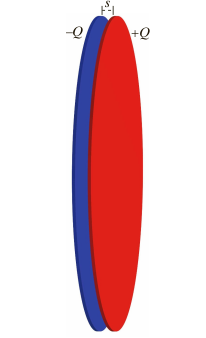Capacitor: Difference between revisions
No edit summary |
|||
| Line 87: | Line 87: | ||
<math> Q= 3e6*8.85e-12*0.785 = 2.01e-5 </math> | <math> Q= 3e6*8.85e-12*0.785 = 2.01e-5 </math> | ||
<math> | <math> Fringe_field = \frac{Q/A}{2\epsilon_0 }(s/R)</math> | ||
<math> \frac{2.01e-5/0.785}{2\epsilon_0 }(0.001/0.5) = 3000 N/C</math> | <math> \frac{(2.01e-5)/(0.785)}{2\epsilon_0 }(0.001/0.5) = 3000 N/C</math> | ||
==References== | ==References== | ||
Matter and Interactions, 4th Edition | Matter and Interactions, 4th Edition | ||
Revision as of 17:49, 29 November 2015
Short Description of Topic
This page is all about the Electric Field due to a Point Charge.
Electric Field

Electric Field of two uniformly charged disks: A Capacitor
The Electric Field of a Capacitor can be found by the formula:
Electric field near the center of a two-plate capacitor
[math]\displaystyle{ \ E=\frac{Q/A}{\epsilon_0 } }[/math] One plate has charge [math]\displaystyle{ \ +Q }[/math] and other plate has charge [math]\displaystyle{ \ -Q }[/math]; each plate has area A; Direction is perpendicular to the plates. Assumption: separation between capacitor is very small compared to the area of a plate.
Fringe Field (just outside the plates near center of disk)
[math]\displaystyle{ \ E_{fringe}=\frac{Q/A}{2\epsilon_0 }(\frac{s}{R}) }[/math] [math]\displaystyle{ \ s }[/math] is the separation between plates; [math]\displaystyle{ \ R }[/math] is the radius of plate
The Algorithm
Step 1. Cut up the charge distribution into pieces and find the direction of [math]\displaystyle{ \Delta \vec{E} }[/math] at each location
Approximate electric field of a uniformly charged disk [math]\displaystyle{ \ E=\frac{Q/A}{2\epsilon_0 }[1-\frac{s}{R}] }[/math] or [math]\displaystyle{ \ E=\frac{Q/A}{2\epsilon_0 } }[/math]
At location 2, midpoint between two disks, both disks contribute electric field in the same direction. Therefore, [math]\displaystyle{ \vec{E}_{net} }[/math] is the largest at this location.
At location 1, because negative charged plate is closer, [math]\displaystyle{ \vec{E}_{net} }[/math] is to the right.
At location 3, because positive charged plate is closer, [math]\displaystyle{ \vec{E}_{net} }[/math] is to the left.
Step 2. Find the electric field of each plate
Assumption: Ignore the electric field due to the small charges on the outer surface of the capacitor since it's very small; Assume that separation between capacitor is very small compared to radius or a disk; consider that location 1 and 3 are just near the disk
To make equation valid at all locations, choose origin at the inner face of the left disk so Electric field of the negative charged plate is [math]\displaystyle{ \ E_{-}=\frac{Q/A}{2\epsilon_0 }[1-\frac{s}{R}] }[/math] to the left and Electric field of the positive charged plate is [math]\displaystyle{ \ E_{+}=\frac{Q/A}{2\epsilon_0 }[1-\frac{s-z}{R}] }[/math] to the left
Step 3. Add up
Location 2: Therefore, the location 2, middle of the capacitor, is located z from the negative charged plate and s-z from the positive plate. Since they are in same direction, we simply add them to find [math]\displaystyle{ \vec{E}_{net} }[/math]
[math]\displaystyle{ \vec{E}_{net} = \ E_{-} + \ E_{+} =\frac{Q/A}{2\epsilon_0 }[1-\frac{z}{R}] + \frac{Q/A}{2\epsilon_0 }[1-\frac{s-z}{R}] = \frac{Q/A}{\epsilon_0 }[1-\frac{s/2}{R}] = \frac{Q/A}{\epsilon_0 } }[/math]
Location 1: At location 1, we can see that [math]\displaystyle{ \vec{E}_{net} = \ E_{-} - \ E_{+} = \frac{Q/A}{2\epsilon_0 }[1-\frac{z}{R}] - \frac{Q/A}{2\epsilon_0 }[1-\frac{z+s}{R}] = \frac{Q/A}{2\epsilon_0 }(s/R) }[/math]
Location 3: At location 1, we can see that [math]\displaystyle{ \vec{E}_{net} = \ E_{+} - \ E_{-} = \frac{Q/A}{2\epsilon_0 }[1-\frac{z-s}{R}] - \frac{Q/A}{2\epsilon_0 }[1-\frac{z}{R}] = \frac{Q/A}{2\epsilon_0 }(s/R) }[/math]
Step 4. Check Unit
[math]\displaystyle{ \frac{C/m^2}{N*m^2/C^2} = \frac{N}{C} }[/math]
[math]\displaystyle{ (\frac{C/m^2}{N*m^2/C^2})(m/m) = \frac{N}{C} }[/math]
Examples
For a two-disk capacitor with radius 50cm with gap of 1mm what is the maximum charge that can be placed on the disks without a spark forming? Under these conditions, what is the strength of the fringe field just outside the center of the capacitor? The air breaks down and a spark forms when the electric field in air exceeds 3e6 N/C
First, convert lengths to meter
[math]\displaystyle{ 50cm = 0.5 m }[/math]
[math]\displaystyle{ 1mm = 0.001mm }[/math]
Second, set up the equation [math]\displaystyle{ 3e6 N/C= \frac{Q/A}{\epsilon_0 } }[/math]
Third, solve for Q
[math]\displaystyle{ A= 0.5*0.5*3.14 = 0.785 }[/math]
[math]\displaystyle{ Q= 3e6*8.85e-12*0.785 = 2.01e-5 }[/math]
[math]\displaystyle{ Fringe_field = \frac{Q/A}{2\epsilon_0 }(s/R) }[/math]
[math]\displaystyle{ \frac{(2.01e-5)/(0.785)}{2\epsilon_0 }(0.001/0.5) = 3000 N/C }[/math]
References
Matter and Interactions, 4th Edition